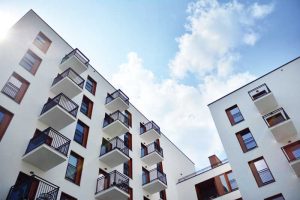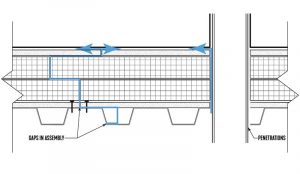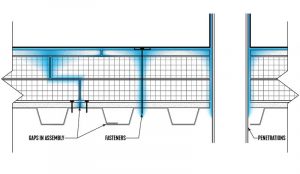by Sarah K. Flock, CDT, AIA, and Andrew Dunlap, AIA, CDT, LEED AP, NCARB

The COVID-19 pandemic has reintroduced the importance of infection control in the built environment. COVID-19 is a novel infectious disease and is understood to be caused by severe acute respiratory syndrome coronavirus 2 (SARS-CoV-2), which ongoing research suggests is transmitted primarily through aerosols. While past pandemics led to design advancements in city planning and urban improvements, infectious diseases transmitted through aerosols can also be impacted by appropriately designed and installed mechanical and enclosure systems. Therefore, while curing and combatting COVID-19 in patients remains under development in the medical field, many design-, and construction-related industry groups have been working hard to understand other ways to prevent the spread in enclosed spaces.

Images © Ryan Asava, AIA, NCARB
On April 14, 2020, the American Society of Heating, Refrigerating and Air-conditioning Engineers Position Document (ASHRAE PD) was released to offer guidance to mitigate disease transmission and as a reference for building readiness for post-pandemic return to operation. While the ASHRAE PD advises increased ventilation is not capable of addressing all aspects of infection control, changes to building operations, including the mechanical systems, can reduce airborne exposures. Though the ASHRAE PD does not make a definitive recommendation on indoor temperature and humidity set points for the purpose of controlling infectious aerosol transmission, it does offer immunobiologists correlated mid-range humidity levels with improved immunity against respiratory infections and unfavorable survival rates for microorganisms when the relative humidity (RH) is between 40 and 60 percent. Further, the research associated with the ASHRAE PD have shown a correlating increase in infections when the interior environmental conditions fall below the 40 percent RH.

Based on this, practitioners are left to evaluate if RH levels between 40 and 60 percent are viable and/or advisable for their existing building design or operation. Other factors can also come into play prior to adoption and implementation, such as building use and pressurization, general climatic conditions, the amount of time occupants are indoors, and limitations of the existing building mechanical system. An imperative consideration is also the impact on the building enclosure should interior climatic setbacks be elevated to levels recommended by current research for both new and existing buildings. This article explores the performance of existing building enclosures in climate zones with colder wintertime temperatures in response to interior environmental setpoint changes, as well as the increased importance for air barrier systems.
Enclosure design and performance
If altering the operating conditions in an existing building is being considered, the enclosure design and construction, such as the walls, roof, fenestration, and below-grade assemblies, must be understood as well as their respective air, thermal, and vapor control strategies. Air, thermal, and vapor control fundamentals have congruences and differentiations but can work together to prevent dewpoint conditions, the temperature at which humidity in the air will begin to condense. Should humidified air encounter a surface below dewpoint, condensation can result, with an increased potential for premature deterioration of building components, corrosion, or mold formation. Buildings in colder climates are particularly susceptible to these concerns.





A great article. There should be more articles like this.